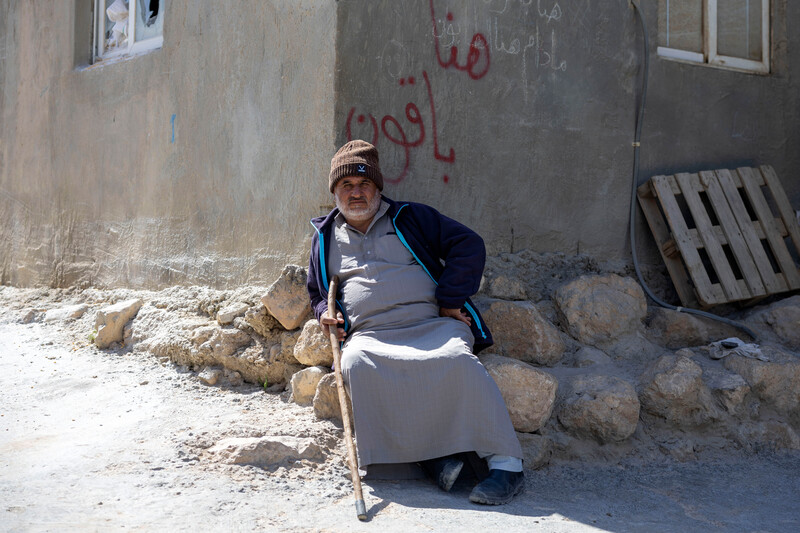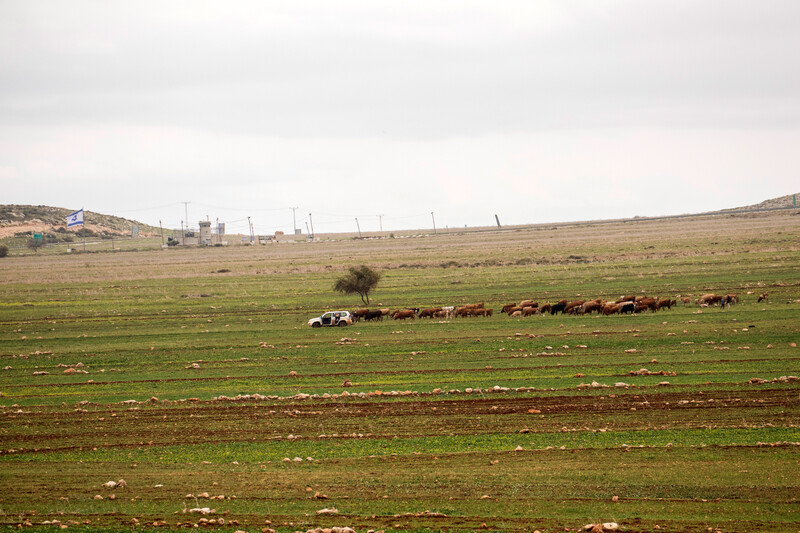Rights and Accountability 23 April 2025

An Israeli settler smiles next to Israeli soldiers as settlers invade Khirbet at-Twail, south of Nablus in the occupied West Bank, where a recently displaced Palestinian community now lives, on 29 March 2025.
ActiveStillsThe Israeli government is accelerating facts on the ground to annex the occupied West Bank.
Israel’s far-right finance minister Bezalel Smotrich dubbed 2025 the “year of sovereignty in Judea and Samaria” – the pseudo-biblical name Israel uses for the West Bank in order to give its occupation and illegal colonization a veneer of legitimacy.
Coupled with accelerating settler violence that surged by 30 percent compared to the same period last year, the Israeli government has been implementing a series of changes to policy and administration in the West Bank that is fundamentally changing the territory’s character while evading international scrutiny.
This is helping to realize longtime Israeli ambitions to tighten Palestinian bantustans while enhancing continuity between Jewish settlements and present-day Israel.
In the first three months of the year, more Israeli settlement units have been approved than in all of 2024 combined.
Israel’s so-called Higher Planning Council, which manages settlement activity, approved over 14,000 housing units in less than three months, surpassing the nearly 10,000 units approved during all of last year.
This is in part due to the “dramatic” change in policy under the current Israeli government that reinvented the process in favor of accelerating settlement building and expansion, according to settlement watchdog group Peace Now.
This policy direction, as well as “the detailed blueprint for annexing the West Bank was outlined in the coalition agreements signed at the government’s inception,” The Jerusalem Post reported.
Quiet annexation
The aim is “to cement Israel’s control over it without being accused of formally annexing it,” as The New York Times described it last June in light of a speech Smotrich gave to settlers.
“I’m telling you, it’s mega-dramatic,” Smotrich told the settlers.
“Such changes change a system’s DNA.”
Smotrich was working on transferring Israeli military authority of the West Bank to civilian control by creating in 2023 a “settlement administration” within Israel’s defense ministry that reports directly to him.
“It will be easier to swallow in the international and legal context,” Smotrich said, “So that they won’t say that we are doing annexation here.”
Israeli jurists believe that “this move in itself constitutes an annexation of the West Bank,” the Tel Aviv daily Haaretz said this month.
The chief of staff of the administration does not try to conceal its objectives either, which is for the state to treat the West Bank as it would any other region in Israel – such as the Galilee in the north or the Naqab in the south – and “to impose Israeli sovereignty in Judea and Samaria.”
Just months before 7 October 2023, the Israeli government transferred the responsibility for planning settlements to Smotrich.
The government also changed the planning and approval procedures for building and expanding settlements. The prime minister’s green light is no longer required, for example.
The changes slashed multiple stages of settlement approval during which the Israeli “defense” minister could influence the process, effectively turning the issue of expanding settlements in the occupied West Bank – all of which are illegal under international law and constitute a war crime – into “an internal Israeli matter, similar to expanding a neighborhood within Israel’s borders,” Peace Now said.
This gave way for “unrestricted construction in the West Bank,” Peace Now stated at the time.
“This decision is pushing Israel towards full annexation and the establishment of an apartheid regime. Planning is now in the hands of Smotrich,” the group added.
Now, nearly two years after these changes, the settlement planning council, which used to meet four times a year, now meets on a weekly basis. In those meetings, hundreds of construction settlement plans are processed and approved.
This shift appears to be part of the government’s strategy to normalize settlement planning, reduce domestic and international scrutiny and capitalize on the global focus on Gaza to rapidly advance settlement expansion,” Peace Now said last month.
The council’s acceleration of government-approved settlement expansion comes hand in glove with a sharp increase in Israeli settler violence against Palestinians, which has driven dozens of Palestinian herding communities from their homes.
Access restrictions
Last month, the Israeli government took steps towards severing the northern and southern parts of the West Bank from one another.
Israel’s so-called security cabinet allocated more than $90 million to build a road that can only be used by Israelis that would “close off a vast area in the heart of the West Bank to Palestinians.”
Building this road would help Israel fulfill its long-time goal of expanding the mega-settlement of Maaleh Adumim in the so-called E1 area, east of Jerusalem, completing the isolation of the northern and southern parts of the West Bank from each other.
This is why Naftali Bennett dubbed it the “sovereignty” road when he was the Israeli defense minister.
In the Civil Administration – Israel’s bureaucratic arm of its military occupation – it is known as the “fabric of life” road, ostensibly “because it is intended to allow Palestinians to maintain a fabric of life after Israel closes off the entire area to them,” Peace Now said.
The cabinet also allocated nearly $3 million dollars for a road that would allow Palestinian movement from the Bethlehem area to Jericho in the western area of the West Bank after closing the center to Palestinians.
“This road serves no purpose in improving Palestinian transportation. Instead, it is solely aimed at facilitating the annexation of a vast area, approximately 3 percent of the West Bank, into Israel,” the group said.
Leading cause in forcible displacement
Since 7 October 2023, as Israeli military raids of Palestinian cities and refugee camps reached new peaks of violence, Israel has severely restricted the movement of Palestinians across the West Bank.
The United Nations monitoring group OCHA began recording data in 2009 on the steady ethnic cleansing of Palestinians in the West Bank. Until recently, Israeli home demolitions for building without permits was the leading cause of Palestinian forcible displacement.

A Palestinian resident of the village of Jinba in the Masafer Yatta area in the southern occupied West Bank, sits against a well with graffiti that reads “we will remain here,” days after a settler attack, on 30 March 2025.
Israel has refused to permit nearly all Palestinian construction in Area C, which constitutes 60 percent of the West Bank and is under complete Israeli military rule under the terms of the Oslo accords signed between Israel and the Palestine Liberation Organization in the 1990s. In reality, the Israeli military controls the whole of the West Bank and has been conducting raids in the smaller areas where the Palestinian Authority has nominal control.
Israel’s refusal to issue building permits forces Palestinians to build without them and live in constant fear that their homes or communities will be demolished.
But there was a shift over the past two years.
In 2023, settler violence became the number one cause for Palestinian displacement, with more than 1,600 Palestinians – mainly Bedouin and herding communities in those areas – forcibly displaced from their homes and communities due to escalating violence by settlers and access restriction. Israel’s lack-of-permit demolitions forcibly displaced 300 people in these communities that year.
In 2024, those numbers were at 620 people displaced by settler violence and access restrictions, and nearly 370 by demolitions in those communities.
Settler-related incidents against Palestinians increased nearly sevenfold between 2020 and 2024.
More outposts, more violence
One reason for the sharp increase in settler violence against Palestinians is the accelerating establishment of illegal outposts across the West Bank.
What Israel refers to as “outposts” are often built without even Israel’s permission and are considered illegal under Israeli law.
In their early stages, they often comprise a small number of the more extreme settlers gathering in a certain area with few caravans or structures, often unconnected to water and electricity. Smotrich is attempting to streamline the process of legalizing and recognizing outposts under Israeli law by providing them with basic services and creating facts on the ground.
At least 59 Israeli “outposts” were established in the West Bank last year – an unprecedented number.
To compare, less than seven outposts were established in the West Bank on average each year since 1996.
Over the past three years, Israeli settlers have stolen large swathes of Palestinian land by establishing supposed shepherding or agricultural outposts throughout the occupied West Bank.

Israeli settlers invade Khirbet at-Twail, south of Nablus in the occupied West Bank, where a recently displaced Palestinian community now lives, with cows, on 29 March 2025.
ActiveStillsThis has long been a tool implemented by Israeli settlers – acting as the state’s colonial foot soldiers – to steal Palestinian land.
Smotrich previously discussed creating a “legalization bypass route” for outposts, by funding and providing services to them as a method to pave the way for taking over Palestinian land.
“The farm outposts are a mega-strategic tool for the protection of lands,” he said.
“We did not invent the wheel. Always in the state of Israel, pasture has been the most effective tool for preserving lands,” he added.
A recent report by Peace Now and Kerem Navot, an organization that monitors and researches Israeli land policy in the West Bank, reveals that 14 percent of the West Bank’s total area was seized through “shepherding outposts.”
But in the previous three years alone, 70 percent of all land seized by settlers had been taken under the guise of grazing activities.
Nearly 36 percent of that land is privately owned by Palestinians.
The report revealed that settlers were awarded “contracts” by the “Settlement Division” of the World Zionist Organization, which was “entrusted by the [Israeli] state with managing hundreds of thousands of dunams of land – without oversight and out of the public eye.”
The contracts provide settlers with hundreds, if not thousands, of acres of land for supposed “grazing” purposes. The World Zionist Organization gives this land to settlers without a tender process or requiring any financial compensation.
Predictably, “in nearly all instances, settlers have constructed illegal outposts on or near the land,” the report says.
In nearly half of the contracts obtained by the Israeli watchdog groups through a freedom of information request with the agriculture ministry, the size of the land allocated to settlers is not even mentioned.
Most were poorly drawn and didn’t specify specific boundaries for the land, with some encroaching on privately owned Palestinian land.
“This violates military law in the West Bank, which prohibits the allocation of private land to anyone – neither the Settlement Division nor settlers,” the report said.
“These flawed mapping practices are not coincidental. The confusion and lack of clarity serve the interests of shepherding outposts, allowing them to seize as much land as possible while systematically displacing Palestinian residents.”
Settlers are also materially backed by the Israeli government, which through “a complex financial system funnels tens of millions of shekels annually to these illegal outposts,” the report says.
In this manner, settlers act as Israel’s foot soldiers to create facts on the ground for the annexation of the West Bank.





Add new comment